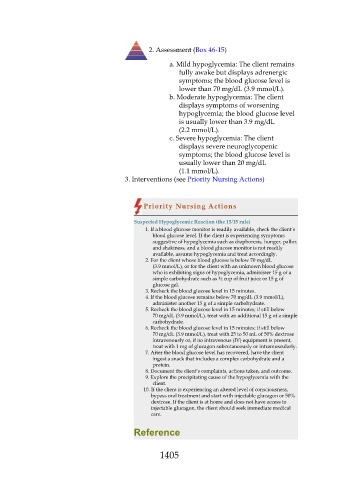Page 1405 - Saunders Comprehensive Review For NCLEX-RN
P. 1405
2. Assessment (Box 46-15)
a. Mild hypoglycemia: The client remains
fully awake but displays adrenergic
symptoms; the blood glucose level is
lower than 70 mg/dL (3.9 mmol/L).
b. Moderate hypoglycemia: The client
displays symptoms of worsening
hypoglycemia; the blood glucose level
is usually lower than 3.9 mg/dL
(2.2 mmol/L).
c. Severe hypoglycemia: The client
displays severe neuroglycopenic
symptoms; the blood glucose level is
usually lower than 20 mg/dL
(1.1 mmol/L).
3. Interventions (see Priority Nursing Actions)
Priority Nursing Actions
Suspected Hypoglycemic Reaction (the 15/15 rule)
1. If a blood glucose monitor is readily available, check the client’s
blood glucose level. If the client is experiencing symptoms
suggestive of hypoglycemia such as diaphoresis, hunger, pallor,
and shakiness, and a blood glucose monitor is not readily
available, assume hypoglycemia and treat accordingly.
2. For the client whose blood glucose is below 70 mg/dL
(3.9 mmol/L), or for the client with an unknown blood glucose
who is exhibiting signs of hypoglycemia, administer 15 g of a
simple carbohydrate such as ½ cup of fruit juice or 15 g of
glucose gel.
3. Recheck the blood glucose level in 15 minutes.
4. If the blood glucose remains below 70 mg/dL (3.9 mmol/L),
administer another 15 g of a simple carbohydrate.
5. Recheck the blood glucose level in 15 minutes; if still below
70 mg/dL (3.9 mmol/L), treat with an additional 15 g of a simple
carbohydrate.
6. Recheck the blood glucose level in 15 minutes; if still below
70 mg/dL (3.9 mmol/L), treat with 25 to 50 mL of 50% dextrose
intravenously or, if no intravenous (IV) equipment is present,
treat with 1 mg of glucagon subcutaneously or intramuscularly.
7. After the blood glucose level has recovered, have the client
ingest a snack that includes a complex carbohydrate and a
protein.
8. Document the client’s complaints, actions taken, and outcome.
9. Explore the precipitating cause of the hypoglycemia with the
client.
10. If the client is experiencing an altered level of consciousness,
bypass oral treatment and start with injectable glucagon or 50%
dextrose. If the client is at home and does not have access to
injectable glucagon, the client should seek immediate medical
care.
Reference
1405

